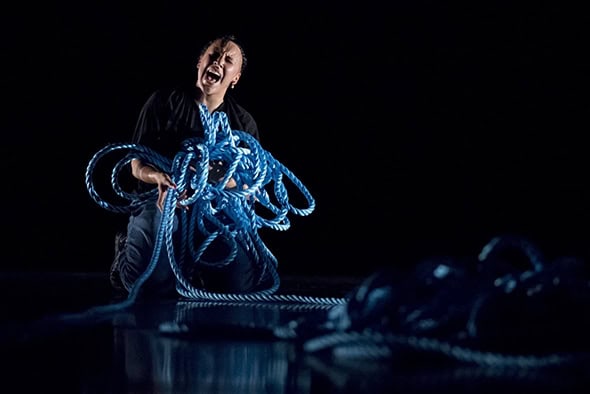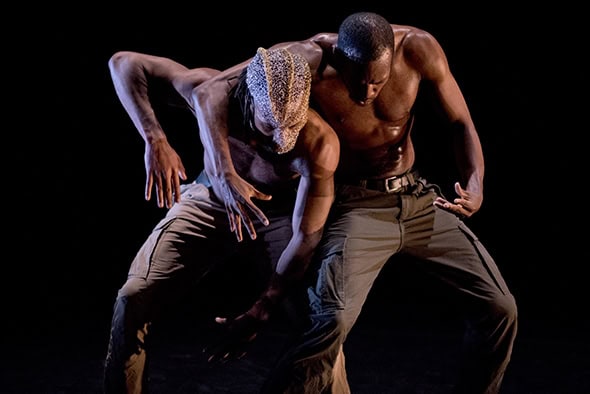Artists 4 Artists double bill of Chris Reyes and Kloe Dean
Posted: August 8th, 2019 | Author: Ian Abbott | Filed under: Performance | Tags: Afua Hirsch, Artists 4 Artists, Chris Reyes, Ignition Dance Festival, Kloe Dean, Man Up, Maxwell Golden, Mikiel Donovan, Sean | Comments Off on Artists 4 Artists double bill of Chris Reyes and Kloe DeanArtists 4 Artists Double Bill of Chris Reyes and Kloe Dean, July 30, Laban

Choreographically the space between the torso and the head is rarely a focus; it’s often used to draw attention elsewhere, a passing place, an in-between place towards more important sites. The emotionally affecting Hip Hop theatre double bill of Sean by Chris Reyes and Man Up by Kloe Dean uses the neck — as a site of power, as a radar of threat, as an antenna of pleasure — from which to explore two autobiographical experiences.
Sean is a 35-minute work that Reyes frames as ‘a journey of displacement, family and migration. Sean (British-born Filipino) shares his stories and the memories of early immigrant, Rosemary (Sean’s mum). What does it mean to be British born?’ The opening twenty minutes see Reyes and Jonadette Carpio creating and establishing a danceless narrative of a complex mother/son relationship; Carpio’s character has left the Philippines and heads to Britain to give her son a better life where she takes up a cleaning job to support him, but Reyes’s character does not achieve enough for his mother, turning him subsequently to drink (manifested by a black morph-suited cameo from Mikiel Donovan).
Emotional contagion and inherited familial trauma is complex territory to explore but Reyes — with support from Maxwell Golden’s dramaturgy — uses a suite of theatrical techniques to hook the audience: “I’ve been sober five years today” or “I saved all my lunch money to buy my mum a small fish.” It’s an efficient twenty minutes although it felt a little obvious that the bait lines we’ve swallowed will be reused later in the show.
Sean suffers slightly from the intensely autographical work it is paired with; we are left unsure of its emotional construction. How removed is Sean from Reyes’ own experience? How much is autobiographical and how much is fiction? Reyes is entirely credible in the role of Sean (and it feels like a deeper dive into a character than he created for a previous work, Caravan) but the artifice of a younger Carpio playing his mother isn’t convincing and distances us emotionally again. However, the intensity of their final fifteen-minute duet, with its focus on the power of the neck, speaks of emotional violence and restrictions. We feel the tension through the choke holds that bleed into lift hugs, and in focusing entirely on to their inability to shed/embrace their identity they own the large stage. It’s electric. The earlier use of language and the emotional spoon-feeding isn’t necessary; their physical communication is strong enough to convey what they want without recourse to words.
There is something about the notion of ‘enough’ that links the work and its author; was Sean good enough for his mother? As someone who is British-born, is Sean’s character British enough? Is he Filipino enough? Is there enough dance in Sean? Is Sean Hip Hop enough? These are the kinds of questions that bubbled up while watching the work. There are many parallels in different media that are currently exploring the notions of ‘enough’ and how individuals sit between worlds; one of the most effective is Brit(ish) by Afua Hirsch; it’s a non-fiction work of memoir/reportage about her time in Senegal and the UK, finding she is considered too British to be Senegalese and too Senegalese to be British. It’s an eloquent reflection on where we (don’t) belong.
Dean’s Man Up is a 35-minute work that has developed substantially from an earlier and shorter iteration presented first at Ignition Dance Festival in June 2018 and four months later at the Startin’ Point Commission Platform at The Place. Man Up is an autobiographical story, adding a comedic twist to the profound and surreal circumstances surrounding her father’s suicide. It explores the stark realities of male suicide and the parallel emotional journeys of those left behind.
There is an audible intake of breath from the audience as Dean emerges out of the tangle of sky-blue ropes on the stage after crouching invisibly under it as still as an iceberg for nearly ten minutes as the audience filtered in for the second half. It’s a stunning opening.
Dean delivers an emotionally devasting movement monologue that zooms in and out of the tiny details that stick with you when you lose a parent. The rasping kiss of the nylon rope on skin as it brushes her radio mic is eerie; we see her carving it across her neck, wrapping it around her wrists and marking out territory on stage.
One of the significant improvements from the previous iteration is the inclusion of composer Teresa Origone, who performs her synth-laden score down stage left in a sonic call-and-response that increases the intensity and depth of feeling on display. Origone weaves layers of lightness amongst the chord progressions which helps to ballast the work.
In some moments it feels like we are unintended witnesses to a series of deeply private moments that weigh heavily; when she sings “I want to do what my daddy does…” because she’s a daddy’s girl or when she happens to be at home on the day her aunt calls at the front door to tell her the news because she’s tired and had uncharacteristically called in sick. These are heart-wrenching moments that feel very, very close.
Dean is captivating in performance, from her original rhymes (sung and spat) that sound a little like Kate Tempest, to all sorts of bgirl flavour, style and power she throws down. Because of the repetitive placement of a noose around her neck, I’m left thinking about Hip Hop as an architecture of air and Hip Hop as suffocation; as she moves the adapted wave tightly around her torso — a taut set of waacks up to and around her face and oodles of other close Hip Hop vocabularies — her body finds it difficult to take up space, to push the air away and move through the emotional weight of the space around her.
It is heartening to see two artists exploring the social/political weight of events through Hip Hop (and kudos to Artists 4 Artists for supporting them); for a culture that has such a history of resistance, oppression and community we too often see it mis-used to make slick, glib routines that bear little relationship to the culture they exploit. However, Dean has delivered an emotionally resonant Hip Hop work that not only highlights the fact that suicide is the single biggest killer of men under 45 in the UK, but delivers it with craft, intelligence and no shortage of integrity.
